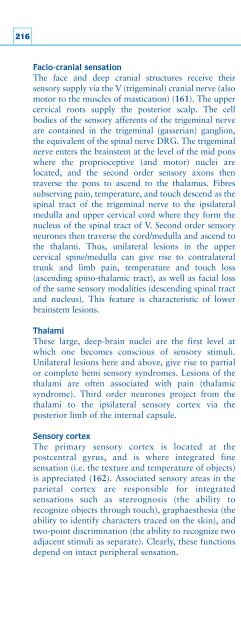Create successful ePaper yourself
Turn your PDF publications into a flip-book with our unique Google optimized e-Paper software.
216Facio-cranial sensationThe face and deep cranial structures receive theirsensory supply via the V (trigeminal) cranial nerve (alsomotor to the muscles of mastication) (161). The uppercervical roots supply the posterior scalp. The cellbodies of the sensory afferents of the trigeminal nerveare contained in the trigeminal (gasserian) ganglion,the equivalent of the spinal nerve DRG. The trigeminalnerve enters the brainstem at the level of the mid ponswhere the proprioceptive (and motor) nuclei arelocated, and the second order sensory axons thentraverse the pons to ascend to the thalamus. Fibressubserving pain, temperature, and touch descend as thespinal tract of the trigeminal nerve to the ipsilateralmedulla and upper cervical cord where they form thenucleus of the spinal tract of V. Second order sensoryneurones then traverse the cord/medulla and ascend tothe thalami. Thus, unilateral lesions in the uppercervical spine/medulla can give rise to contralateraltrunk and limb pain, temperature and touch loss(ascending spino-thalamic tract), as well as facial lossof the same sensory modalities (descending spinal tractand nucleus). This feature is characteristic of lowerbrainstem lesions.ThalamiThese large, deep-brain nuclei are the first level atwhich one becomes conscious of sensory stimuli.Unilateral lesions here and above, give rise to partialor complete hemi sensory syndromes. Lesions of thethalami are often associated with pain (thalamicsyndrome). Third order neurones project from thethalami to the ipsilateral sensory cortex via theposterior limb of the internal capsule.161abTrigeminal nervedivisions:12345678Trigeminal nervedivisions:321Sensory cortexThe primary sensory cortex is located at thepostcentral gyrus, and is where integrated finesensation (i.e. the texture and temperature of objects)is appreciated (162). Associated sensory areas in theparietal cortex are responsible for integratedsensations such as stereognosis (the ability torecognize objects through touch), graphaesthesia (theability to identify characters traced on the skin), andtwo-point discrimination (the ability to recognize twoadjacent stimuli as separate). Clearly, these functionsdepend on intact peripheral sensation.161 Diagram to show the somatotrophic organization of thetrigeminal system. a: peripheral innervation territories of thetrigeminal nerve. 1: ophthalmic; 2: maxillary; 3: mandibulartrigeminal nerve; 4: innervation by cervical sensory roots.b: organization of the spinal trigeminal tract in relation to thethree trigeminal nerve divisions and the glossopharyngealnerves for the portion of the medulla that includes the caudalnucleus. 5: spinal trigeminal nucleus; 6: cuneate nucleus;7: gracile nucleus; 8: glossopharyngeal nucleus.
















